Apple iPad mini with Retina Display: Reviewed
by Anand Lal Shimpi on November 16, 2013 8:00 AM ESTThe SoC
The iPad mini with Retina Display rounds out the three platforms that use Apple’s A7 SoC. Although both the iPad Air and iPhone 5S use the A7, the mini’s implementation is closer in nature to the iPhone. The iPad mini’s SoC has always used the same package-on-package (PoP) assembly as the iPhone, with DRAM stacked on top of the SoC itself (1GB in this case). The benefit is obviously a reduction in board area, the downsides have to do with cost and thermals. That’s the first similarity between the mini’s A7 and the iPhone’s A7.
The second is one of frequencies. While the iPad Air’s A7 runs its two Cyclone CPU cores at up to 1.4GHz, the SoC in the iPad mini and the iPhone 5S runs at up to 1.3GHz. That might sound like a minor difference, but it’s far more pronounced when you look at what happens to frequency when you’re running heavy workloads.
Once again I turn to a fairly heavy CPU workload to plot performance over time. This is a multithreaded workload, slightly modified from what we used in the iPad Air review, designed to make the CPU cores consume max power. The scale is linear and the workload is the same across all devices, so what you’re effectively looking at is a graph of thermally bound CPU performance over time across all three A7 implementations:
Being the largest device (and the only device with a metal heat spreader and no DRAM stacked on top), the iPad Air obviously maintains the highest frequencies for the duration of the test. The iPhone 5S, with a significant reduction in internal volume (and a PoP SoC) reduces its CPU frequencies early on in order to keep skin temperature down and properly manage thermals. The iPad mini with Retina Display falls between the two, with its performance curve more closely following that of the iPhone 5S.
Although the mini has a similar max operating frequency to the iPhone 5S, it is a faster device thanks to it being less thermally constrained. Similarly, the iPad Air can be much faster than its clock speed would otherwise imply. If you’re wondering why Apple has been so focused on building its own SoCs and CPU architectures, this is the reason why. There’s a fixed amount of power you can dissipate in the form of heat in these mobile devices while still maintaining a good user experience. Performance per watt is the gating metric for success in mobile, and shipping high IPC/low frequency dual-core SoCs at 32/28nm is the best optimization available to a company like Apple today.
As you’d expect, our browser based CPU tests show the mini’s A7 performing in between the iPhone 5S and iPad Air. None of these tests are anywhere near as stressful as our thermal test from above, so we don’t see exaggerated differences in performance between the platforms. For most, I suspect you won’t notice a huge performance difference between the mini and Air. Those who are heavier users (e.g. audio mixing, 3D gaming, etc…), there will be a performance difference between the two iPads.
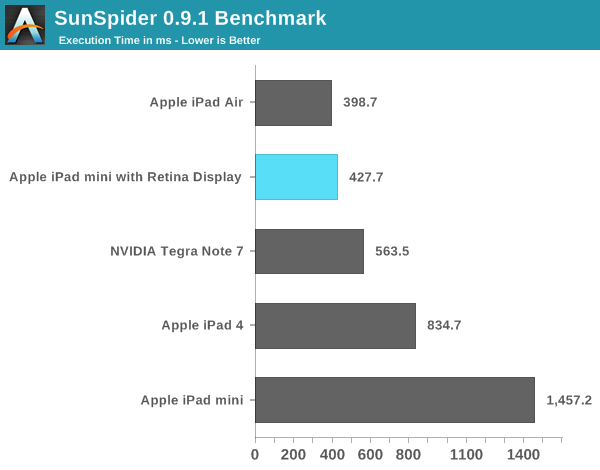

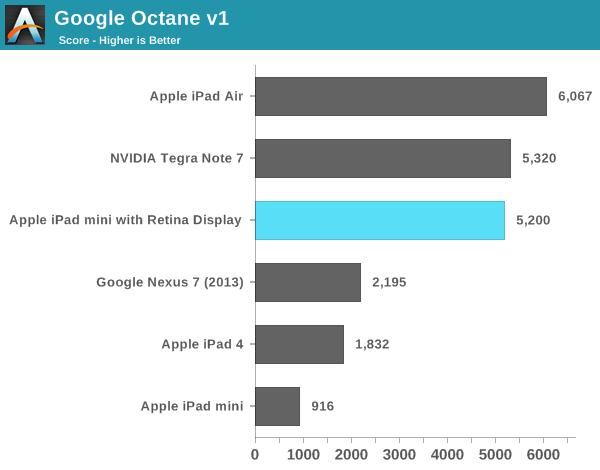
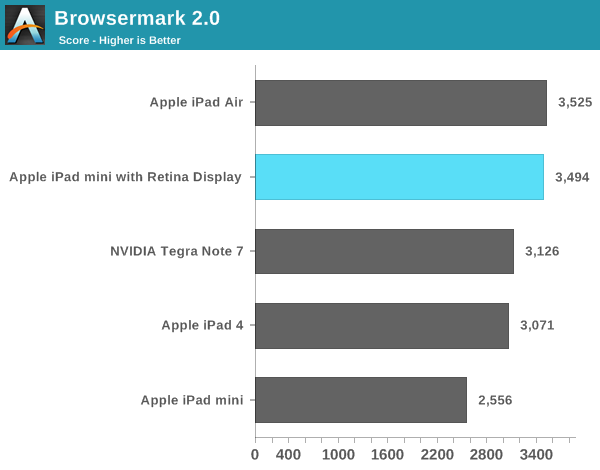
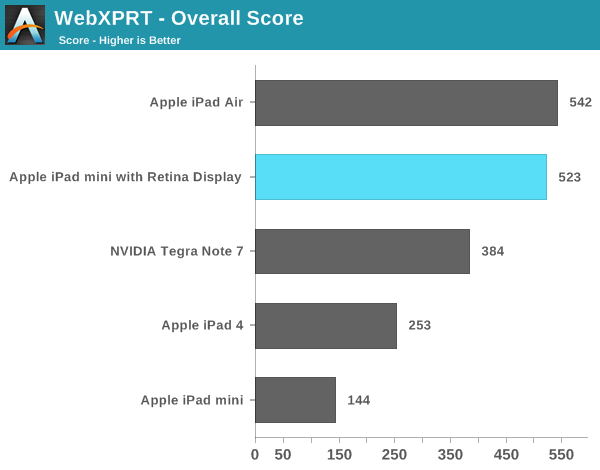
Compared to the first generation iPad mini, the new model is in a completely different performance league. Keep in mind the first mini used Apple’s A5 SoC based on an ARM Cortex A9. That’s the same single threaded performance as what’s in an iPhone 4S, and under iOS 7 it’s clearly running into some performance limits. The new mini with Retina Display however is a completely different animal. It’s fast.
Even comparing to the 4th generation iPad, the new mini is noticeably quicker.
Memory Bandwidth
Looking at the iPad mini’s memory bandwidth curve, we see it tracks very closely with that of the iPhone 5S. This is a slightly modified version of our previous bandwidth test, and you can see peak usable memory bandwidth (from the CPU’s perspective) of around 10GB/s. The ~12GB/s area right before you get out to main memory is bandwidth to the A7’s 4MB system-wide cache that sits after the shared L2 and the memory controller. This cache appears to service CPU, GPU and ISP requests at least.
GPU Performance
I believe the A7’s PowerVR G6430 GPU runs at around 450MHz. This frequency appears unchanged across all three A7 implementations. Once again, the big difference is how much thermal headroom exists in the platform which has an impact on overall performance.
Kishonti’s low level GPU performance tests back up my assertion that GPU frequency is fixed across all A7s. The iPad mini with Retina Display delivers equal performance to the iPad Air. The bigger news here is that nearly all of the GPU bound 3D tests seems to peg the mini and Air as equals. These are some pretty intense tests, but it looks like on the GPU side there’s no significant throttling when running at full tilt.
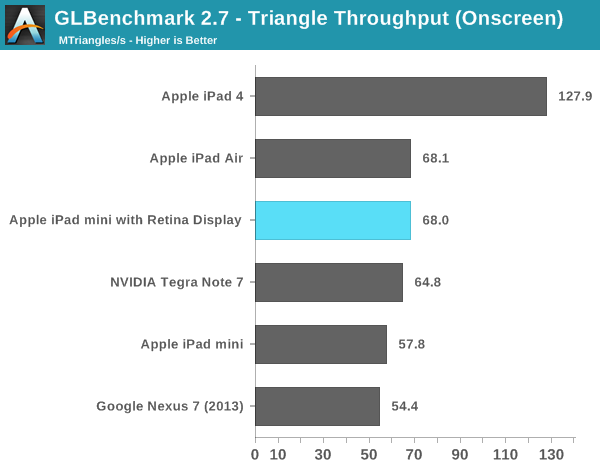

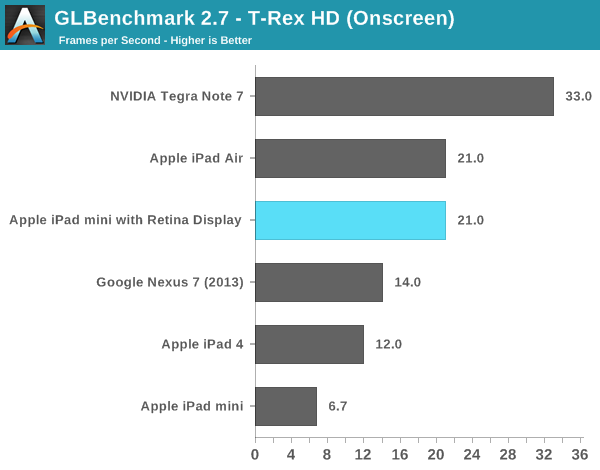

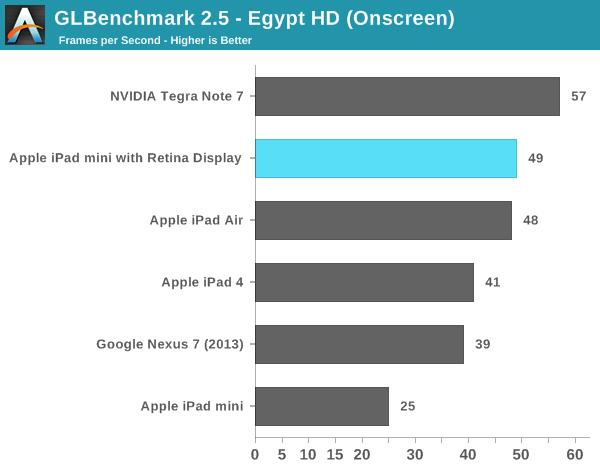
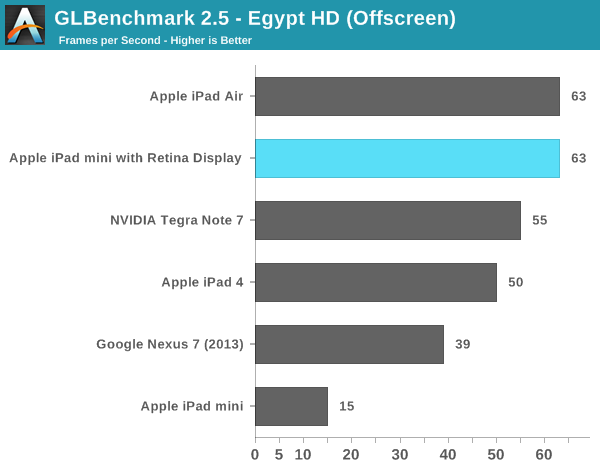
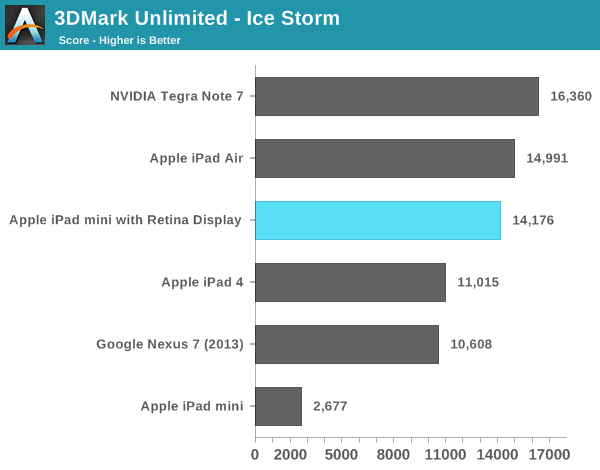
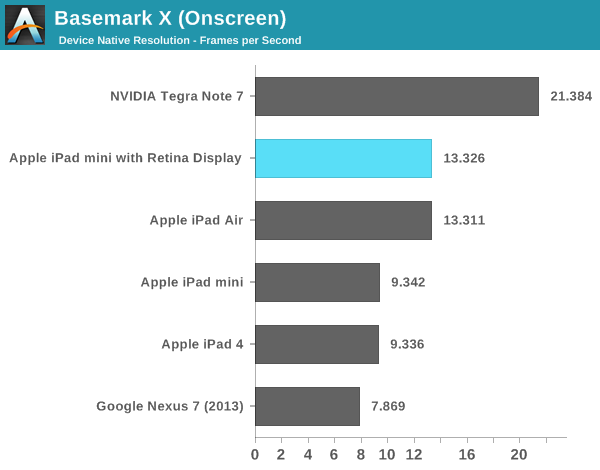
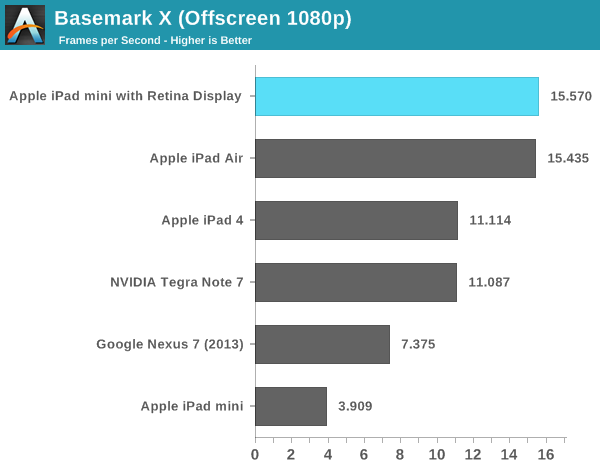
As I mentioned in our iPad Air review, despite having less peak theoretical memory bandwidth than the A5X/A6X, the A7 in the iPad mini never seems to regress in performance compared to even the iPad 4. Across the board the mini appears to be faster, more responsive and have more performance on tap than any prior iPad (big or small). The comparison to the original iPad mini is of course night and day. Even looking at lighter tests like the old GLBench Egypt HD benchmark, the iPad mini with Retina Display manages to be nearly twice as fast as the original mini - all while rendering 4x the number of pixels.


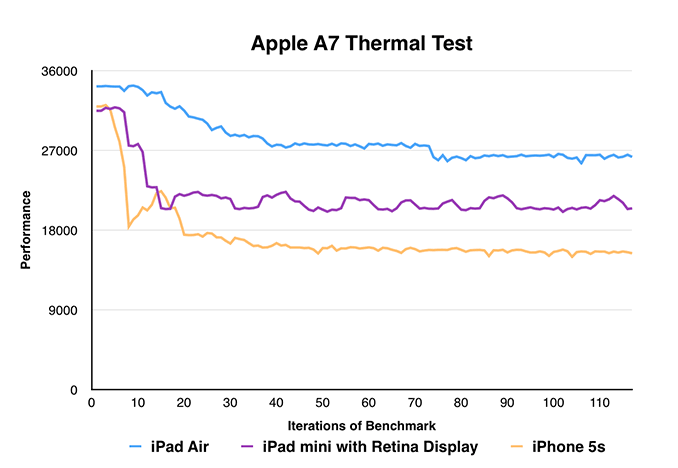
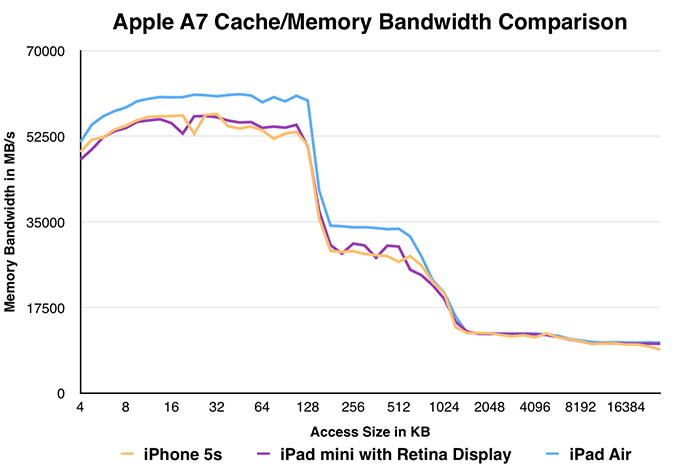








345 Comments
View All Comments
Daniel Egger - Saturday, November 16, 2013 - link
Not sure what you're referring to. I'm a WP user and I wouldn't switch to either Android (which quite frankly sucks totally in my eyes for various reasons) or iOS (because I tend to treat my phones as phone mainly and I expect nothing but the best voice quality and long standby times and best usability which quite frankly still sucks for all current smartphones but the Lumias still offer the best compromise of all -- I certainly don't need the features of an iPhone and I won't pay 4 times the price for the same value as a phone). On the other side my main workhorse is a MBP and there's no device I could be (and have been since 2001) more productive on than a Mac, I also have two iPod Touches for casual games and music and I'm looking forward to getting the new Mini as well (although I did buy a Surface RT some time ago which still really sucks for anything but Web browsing/Flash video watching and working with Office documents).Although Anand really appreciates Apple products for personal and professional I don't think this site has a particular strong bias towards them, especially given the flood of recent Android reviews by Brian that received glowing verdicts. Also there're plenty of reviews of displays reviews, windows laptops and misc hardware like PSUs, GPUs, games, etc. all of which are not in any way related to Apple products.
Scannall - Saturday, November 16, 2013 - link
The iPad is a much nicer device, and overall price is a wash. The ipad will still have great resale value in a couple years. The Nexus 7 will be a garage sale special. So upgrading will be cheaper, with the added benefit of using a better tablet.Brakken - Sunday, November 17, 2013 - link
A first time purchase seems to indicate a second time purchase. Which means spending even more money.The wonderful thing about the HTC's with dr beat and the Apple devices is great sound and (not so much for the HTC) a great music player. Android doesn't natively have such things, which means searching fro something that works. I know, I've tried.
And being at college and having to carry around a rather elongated thing that MUST have a physical keyboard for use, or a wonderfully misplacable OneNote item, seems like missing the point.
If you don't (or your daughter?) appreciate being able to whip out a device, make some notes, wherever one happens to be, and then get back to the next situation, then I'm not sure why you are bothering to cast aspersions here.
Failing to understand the pleasure of a product that was designed in a particular way, that has an integrated OS that functions remarkably smoothly (even on three year old devices!), and that such things cost more to develop and produce, simply means that Apple products are not for you (or your daughter?)
Please be aware that there are several million people who have different values, and 'nice' isn't what this review is about. It's about what the latest in SoC can achieve and the benefits of an integrated soft/hardware approach can bring. Perhaps Google/Android/Motorola/Asus/Whomever will get there one day, but not soon, I think.
melgross - Sunday, November 17, 2013 - link
Have you not considered that he switched because their products actually are better? I think so. I've used many products over the years, but have always preferred Apple's.akugami - Sunday, November 17, 2013 - link
I felt all of the important points were touched on. Anand mentions that the device is very pricey, especially compared to its closest competitor the Nexus 7 as well as other tablets. Anand also mentions flaws and I felt he touched upon any relevant ones. Lets be honest, Apple has built a very solid tablet that is arguably one of the best. It is up to the consumer to decide whether that price premium is worth buying the N7 or iPad Mini.You also mention that "Apple can do no wrong" in reference to the supposed blind love that Anand has for Apple products shows where you are coming from and shows you already have a bias against Apple. Furthermore, this is an iPad Mini review. This is not a tablet shootout. The reviewer does NOT need to compare multiple devices or even mention any other device.
Mahadragon - Sunday, November 17, 2013 - link
Apple sold 34 million iPhones in their last quarter, 9 million were sold in the opening weekend alone. Apple made $37 billion in revenue and are still the most valuable company in the world. You make it sound like the people at Anandtech are Apple fans. I have news for you, lots of people are Apple fans. Pull your head out of your behind. Apple has millions and millions of fans that buy their stuff every day.If Apple were some 2 bit company that made shoddy products then yes, I could understand your complaint about Anandtech being "biased" toward Apple products. That's not the case.
zeagus - Monday, November 18, 2013 - link
The love at AT is for well designed and performant technology. Apple nails this more often than not. The "Apple Love" here knows only the bounds of the facts. They get dinged for what they fuck up on.sundragon - Monday, November 18, 2013 - link
As an owner of the 2012 and 2013 Nexus 7 and an owner of the new iPad Air, there is a vast difference. My 2012 was replaced 3x and the 2013 was replaced once because it had an issue.You get what you pay for
2. The screen size difference between the Mini and 7 are a lot more than "almost identical" and the OS experience on a 7" display is horrible - it's not even close to being a "tablet experience" and feels like a large phone.
3. Apps on iOS look much better and are better designed than on Android - Blame the devs because it's noticeable and I have both platforms. Some games (fonts and buttons) are unusable on the Nexus 7.
4. I sold my Nexus 7 2013 because it just isn't there and I gave my 2012 to my niece and nephew.
Ultimately the comparison of specs doesn't cut it for those of us who use both platforms. Plus the A7 runs circles around the Snapdragon S4... I may come back to Google in a few years but currently the Apps and experience just aren't fully baked. That's why Samsung puts 3-4GB of bloat skin to make it "acceptable".
And before you go on about Open Source - None of the new Google apps are open source. Gmail, Calendar, Music, Movies, all the new Google apps are closed source... That's why every device is shipped with two email apps, the native android (open source that hasn't been updated in years) and Gmail. Google is slowly moving closed source for all their apps.
P.S. People comment about how awful one platform is vs the other and they don't own the device they are critiquing - Which is absurd.
Tetracycloide - Saturday, November 16, 2013 - link
The last paragraph where he still lists the display as an advantage for the mini retina even though the PPI is basically identical? Not sure if that's a good illustration of the point you're trying to make.KPOM - Saturday, November 16, 2013 - link
The iPad mini's screen is almost 43% larger with a virtually identical PPI, so in some respects it is an advantage. What amazes me is how so many Android fans harp on the iPhone's small screen size but treat a 43% screen area difference between Apple's 4x3 7.85" design and Google/Amazon's 16x9 7" design as if it's nothing.